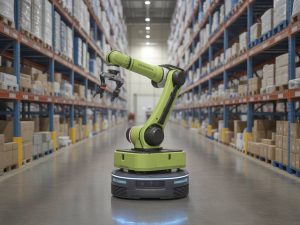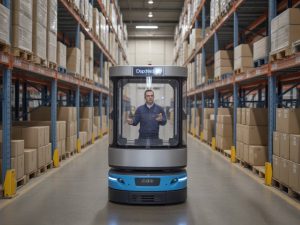Resilience in Supply Chains: How Robotics Are Mitigating Disruption Risks
Understanding Supply Chain Resilience in the Face of Disruption
In an increasingly interconnected world, global supply chains are more complex than ever. These intricate networks are also more vulnerable to unexpected events, from pandemics and natural disasters to geopolitical tensions and cyberattacks. The concept of supply chain resilience — the ability to prepare for, respond to, and recover from disruptions — has become a strategic priority for businesses worldwide.
Traditionally, companies have focused on cost efficiency, with lean inventory systems and just-in-time models. However, recent crises, notably the COVID-19 pandemic and the blockage of the Suez Canal, have exposed the fragility of these systems. Today, supply chain managers are placing a greater emphasis on resilience. And one of the most promising tools in their arsenal? Robotics.
How Robotics Enhance Resilience in Supply Chains
Robotics technology in logistics is redefining how companies approach disruption mitigation. From warehouse automation to autonomous delivery, intelligent robotic systems are minimizing human error, increasing speed, and improving adaptability during operational stress.
Key ways robotics strengthen supply chain resilience include:
- Flexible automation: Robotic systems can rapidly reconfigure to accommodate disruptions in product demand or supply.
- Workforce continuity: During pandemics or labor shortages, robots maintain productivity levels where human labor might be compromised.
- Real-time adaptability: AI-driven robots can optimize logistics flows in real time based on changing variables, such as weather delays or transportation bottlenecks.
- Predictive maintenance: Robotics integrated with IoT sensors detect malfunctions before they become critical, ensuring continuous uptime of equipment.
Warehouse Robotics: Automating the Heart of Fulfillment
Warehouses are the central nodes of most supply chains. Any disruption here can ripple upstream and downstream, affecting suppliers, partners, and customers. Robotic solutions have become indispensable in modern warehouse management.
Technologies like Autonomous Mobile Robots (AMRs) and Automated Guided Vehicles (AGVs) are used for:
- Picking and packing operations with high accuracy
- Transporting goods across fulfillment centers
- Replenishing inventory dynamically based on real-time demand
Unlike traditional conveyor belts or fixed automation, robots can adapt to new tasks and rearrange their workflows depending on the situation. This level of adaptability, combined with machine learning, adds a crucial layer of resilience to the warehouse environment.
Robotics in Transportation and Last-Mile Delivery
One of the most visible disruptions in supply chains occurs during transportation — delays in ports, customs holdups, or driver shortages can severely impact delivery timelines. Robotics is offering solutions here as well:
- Self-driving trucks: Autonomous delivery vehicles reduce dependence on human drivers and can operate 24/7, maintaining delivery timelines even during manpower shortages.
- Drone deliveries: Particularly useful for remote or hard-to-reach areas, drones ensure last-mile delivery even when roads are blocked or congested.
- Robotic loading and unloading: Automated systems at transfer hubs speed up cargo handling processes, reducing dwell time and ensuring better flow through logistics networks.
As companies implement embedded robotics in their logistics fleets, they gain more control over variables that would otherwise be outside human influence. Ensuring smooth transport helps businesses build more robust supply chain networks that can handle sudden shifts or systematic shocks.
AI and Robotics: A Predictive and Preventive Partnership
The real strength of robotics in supply chains comes from integration with artificial intelligence. AI enables predictive analytics, demand forecasting, and behavior modeling, while robotics brings these insights into action.
For example, if an AI system predicts a disruption in regional supply due to weather conditions, robots can pre-emptively rearrange inventory or reroute delivery operations. This predictive-preventive partnership significantly reduces the risk of complete system collapse during disruptions.
Moreover, AI algorithms learn from historical data and real-time inputs. Over time, robots become more intelligent and efficient, helping companies reduce overstocking, shortage risks, and waste, all while boosting operational resilience.
Real-World Examples: Companies Implementing Robotics for Resilience
Several companies have already integrated robotics into supply chain operations to build resilience:
- Amazon: With over 500,000 robotic drive units working in its global fulfillment centers, Amazon has optimized inventory movement while ensuring continuity during labor shortages, particularly during peak pandemic times.
- DHL: A trailblazer in robotic process automation (RPA), DHL has implemented robotic picking systems and AI-driven predictive analytics across its warehouses worldwide.
- Ocado: The UK-based online grocery retailer uses a swarm of collaborative robots in its warehouses to handle hundreds of thousands of orders efficiently, providing agility during demand spikes.
These examples highlight how pioneering enterprises are using robotics not just for efficiency, but as a shield against potential disruptions.
The ROI of Robotics in Risk Mitigation
Implementing robotics in supply chains often involves upfront capital investment. Yet in the context of long-term risk mitigation, the return on investment is increasingly evident. Benefits include:
- Reduced operational downtime during crises
- Higher throughput and less reliance on human labor
- Faster recovery times after disruptions
- Improved on-time delivery rates and customer satisfaction
Moreover, scalability is a key advantage. Robotic systems can be rapidly scaled up or down depending on demand fluctuations — a critical feature for navigating uncertain market conditions.
Building a More Resilient, Robotic Future
With rising uncertainties in global trade and growing customer expectations, supply chain resilience is no longer optional — it is imperative. Robotics, supported by artificial intelligence and real-time data analytics, offers companies the tools they need to withstand shocks, adapt to changes, and emerge stronger from challenges.
As more businesses integrate robotics into their logistics and fulfillment strategies, those that adapt quickly will be better positioned to provide uninterrupted service, meet demand shifts, and maintain a competitive edge. In the years ahead, supply chains fortified with robotics will not only survive disruption — they will thrive through it.
For those exploring solutions to enhance supply chain operations, robotic automation isn’t just a technological upgrade. It’s a resilience strategy that could define future success in a volatile global market.






